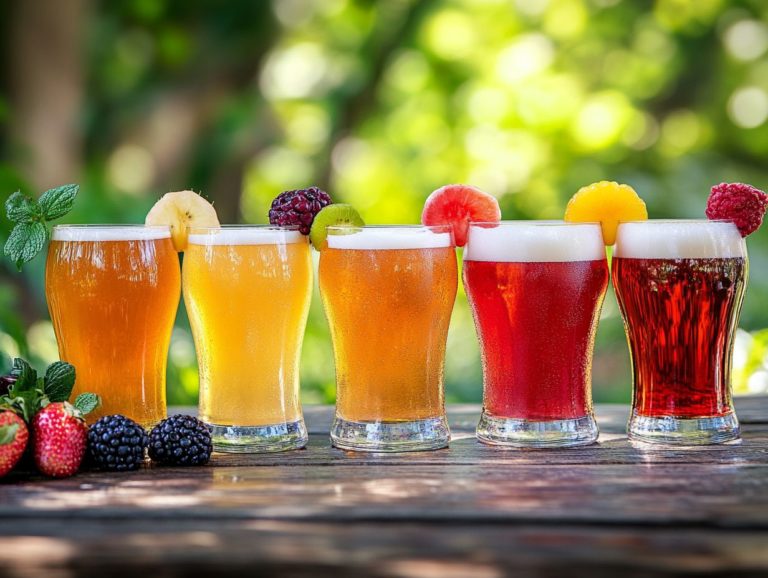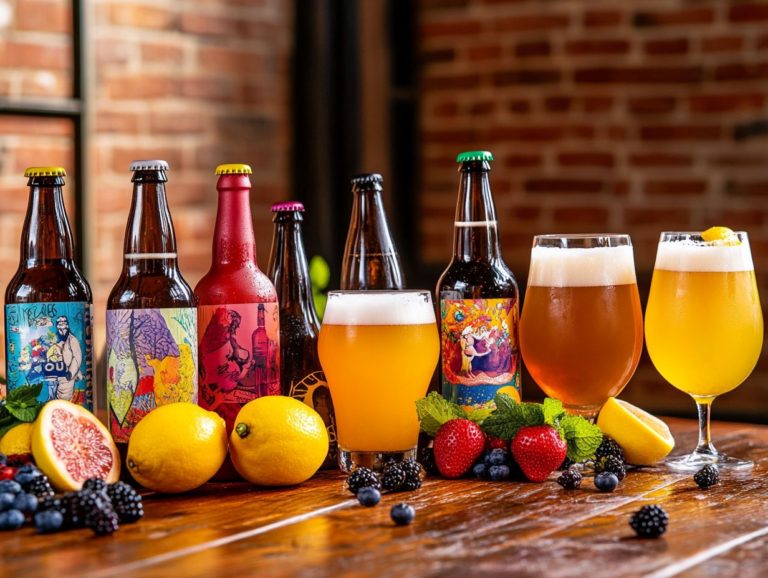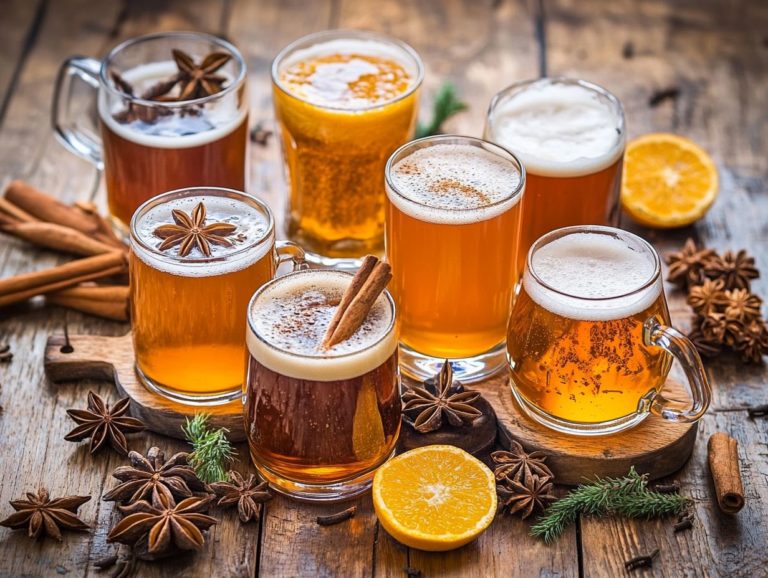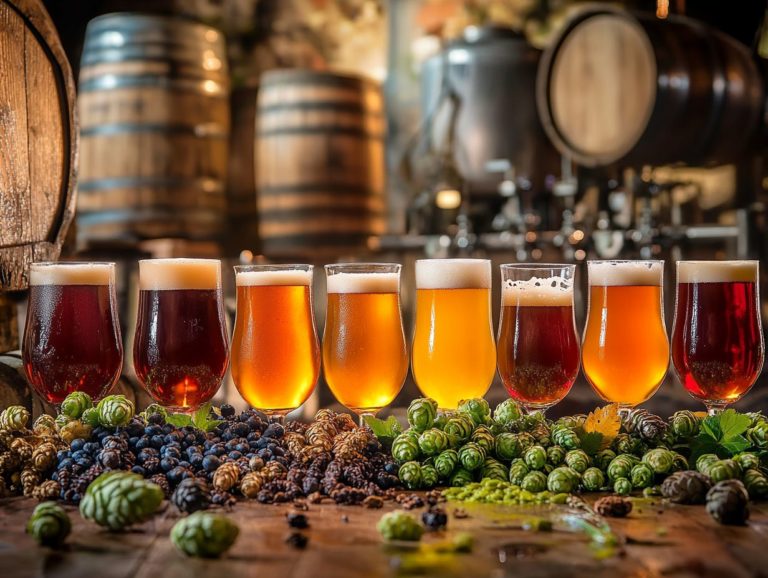The Characteristics of Traditional English Ales
Contents
- Discover Traditional English Ales
- Traditional English Ales
- How Are Traditional English Ales Brewed?
- The Brewing Process
- 4. Aging and Conditioning
- What Are the Best Food Pairings for Traditional English Ales?
- 1. Roast Beef
- 2. Fish and Chips
- Pairings
- Frequently Asked Questions
- What are the main characteristics of traditional English ales?
- What types of hops are commonly used in traditional English ales?
- What is the serving temperature for traditional English ales?
- What makes traditional English ales different from other beer styles?
- Are there different types of traditional English ales?
- Do traditional English ales pair well with food?
Discover Traditional English Ales
Traditional English ales, a key aspect of English beer, stand as a cornerstone of the brewing world, revered for their rich flavors and historical significance. When you delve into these ales, you’ll discover a focus on malt-forward profiles, characterized by low alcohol by volume (ABV), moderate bitterness, and delightful earthy, floral hop notes.
From the iconic Pale Ale to the robust Stout, each variety presents a unique experience waiting for you to explore. This article invites you to discover the defining features, brewing methods, and ideal food pairings of traditional English ales, allowing you to fully appreciate the charm of these classic brews.
Key Takeaways:
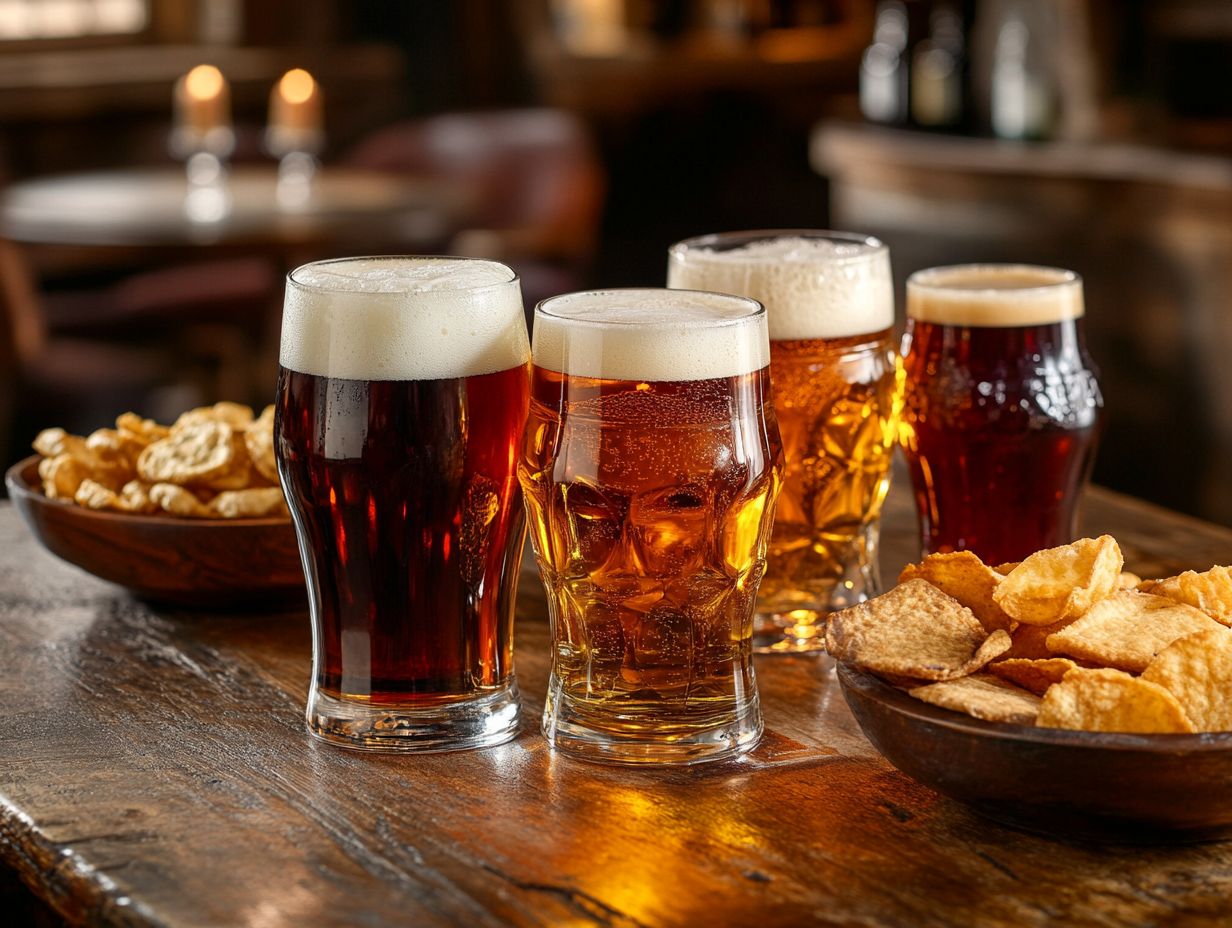
- Traditional English Ales have a malt-forward flavor profile, low alcohol by volume (ABV), moderate bitterness, earthy and floral hops, low carbonation, and darker color.
- The different types of traditional English Ales include Pale Ale, Brown Ale, Porter, and Stout, each with unique characteristics. Notable mentions include English IPA, English Mild, and English Bitter.
- The main ingredients used in traditional English Ales are barley malt, hops, yeast, and water, undergoing a brewing process that includes mashing, boiling, fermentation, and aging.
What Are Traditional English Ales?
Traditional English ales represent a rich and diverse tapestry of beers, deeply rooted in brewing history that mirrors the cultural heritage of the British Empire and Celtic tradition. They embody a strong character, often influenced by seasonal spices and rich malt character.
Explore the vibrant world of traditional English ales, where each sip tells a story. Styles like Brown Ale, English Mild, and India Pale Ale showcase unique characteristics that have evolved over centuries. With an emphasis on malt-forward flavor profiles and a harmonious balance of sweetness and bitterness, these ales exemplify the craftsmanship inherent in English brewing.
Whether you re savoring them alongside hearty beef dishes or celebrating festive occasions, traditional English ales possess a robust character that resonates with a wide array of palates, including those who appreciate toasty Stouts and Newcastle Brown Ale.
What Are the Characteristics of Traditional English Ales?
Traditional English ales offer a malt-forward flavor profile highlighting the distinctive malt character and seasonal spices, crafting a rich tapestry of taste experiences. You ll notice hues ranging from amber to dark ruby, reflecting the diverse brewing techniques used in styles like English Mild and Brown Ale. These flavors are also evident in commercial examples like Ossian and Jaipur IPA.
These ales provide a creamy drinkability, allowing you to fully appreciate the roasted bodies and nutty aromas that define them. The moderate bitterness elegantly balances the sweetness, making them versatile companions for various culinary delights.
1. Malt-forward Flavor Profile
The malt-forward flavor profile of traditional English ales, such as English Mild and Brown Ale, plays a pivotal role in defining their character, delivering a delightful balance of sweetness and complexity.
This distinctive character primarily arises from the diverse range of malt types employed in the brewing process. For example, pale malts form the foundation, imparting a gentle sweetness, while darker malts elevate the profile with notes of nuttiness and subtle hints of chocolate or caramel. When crystal malts are introduced, they add a rich, toasty flavor that shines especially in a well-crafted Brown Ale.
The interplay of these flavors from earthy undertones to malty richness manifests beautifully in classic ales like Old Ale and Winter Warmer. Here, the synergy of these malt characteristics culminates in a satisfying, warming experience that lingers delightfully on the palate, inviting you to savor every sip.
In conclusion, traditional English ales offer a unique journey through flavor and history. Discover your favorite traditional English ale today!
2. Low ABV (Alcohol by Volume)
Many traditional English ales, particularly styles such as English Mild and English Bitter, are celebrated for their low ABV (Alcohol by Volume), typically ranging from 3% to 5%. This makes them perfect for casual drinking sessions where you can savor your choices without feeling pressured.
The lower alcohol content fosters a welcoming atmosphere at social gatherings. You can enjoy these beers over extended periods without feeling overwhelmed. The subtlety of these ales lets the nuanced flavors shine, making them fantastic companions for classic pub fare like fish and chips or hearty pies.
Imagine the joy of sipping a classic English Bitter on a sunny afternoon at the pub, where each sip makes the moment memorable.
The drinkability of these low ABV ales caters to both seasoned enthusiasts and casual drinkers, ensuring that everyone can enjoy themselves without the worry of overindulgence. Commercial examples like Fullers ESB and Heineken Nederland B.V. offer great representations of this style.
3. Moderate Bitterness
The moderate bitterness found in traditional English ales creates a harmonious balance with their malt sweetness, particularly evident in styles such as English IPA and Best Bitter.
This bitterness is primarily measured using the International Bitterness Units (IBU) scale, which gauges how bitter a beer is based on the hops used. Ales that achieve this balance often display complex flavor profiles, where the bitterness complements rather than dominates the underlying malt characteristics.
Take, for instance, an English IPA; it typically showcases a pronounced hop bitterness that interacts beautifully with caramel and toasty malts, weaving together a rich tapestry of flavors. The Best Bitter combines a subtle sweetness with gentle hop notes, delivering a refreshing yet satisfying drinking experience that emphasizes the essential interplay between these two fundamental elements. Other notable mentions include the Winter Warmer and Baltic Porter.
4. Earthy and Floral Hops
The use of earthy and floral hops is a defining characteristic of traditional English ales, adding a level of depth and aroma that beautifully complements the malt profile, particularly in styles like English Porter and Best Bitter.
These hops present subtle notes of grass, pine, and citrus that elevate your overall tasting experience. Varieties such as East Kent Goldings, Fuggles, and Challenger are frequently utilized in these brews, each contributing its own unique flavors and aromas that are sure to captivate your palate. For instance, East Kent Goldings lends a soft, honey-like sweetness, while Fuggles introduces a slightly spicy and woody essence. CAMRA recognizes these varieties for their significant contributions to traditional English ales.
This harmonious interplay of hops with rich, toasty malts can be distinctly appreciated in classic ales like a traditional English Bitter or a robust Porter. Each sip allows you to embark on a complex and enjoyable journey.
5. Low Carbonation
Traditional English ales often present a delightful low carbonation level, creating a creamy and drinkable texture that enhances the overall mouthfeel, particularly in styles like English Sweet Stout.
This low carbonation characteristic fosters a gentle, smooth experience, allowing the nuanced flavors to truly shine. When you savor a well-crafted English Mild Ale, the subdued carbonation highlights richer malt profiles and subtle sweetness, rendering it incredibly refreshing without overwhelming your palate.
Similarly, a perfectly poured English Porter provides a velvety sensation, with soft, creamy bubbles gently caressing your tongue and offering a delightful contrast to the coffee and chocolate undertones. These examples illustrate that lower carbonation is not merely a stylistic choice; it is an essential element that elevates your enjoyment and appreciation of various ales.
6. Darker Color
The deeper hues of many traditional English ales, like Brown Ale and English Porter, hint at their roasted body and complex malt profiles. Together, these elements create rich and inviting flavor experiences.
This captivating coloration isn t just for show; it represents a sophisticated process that utilizes various malt types and roasting techniques to unlock a wide array of flavors. For example, chocolate malt and black malt can produce those deep brown, almost black shades while also adding layers of malty sweetness, along with delightful hints of coffee or caramel. These deep hues are particularly pronounced in styles like English Stout and English Oatmeal Stout.
The roasting process is particularly significant, as it shapes both the aroma and taste an appealing visual characteristic that elevates the overall enjoyment of the drink.
When you pour one of these ales into a glass, it beckons you to explore. It encourages you to take your time with each sip and truly appreciate the artistry that goes into their creation.
What Are the Different Types of Traditional English Ales?
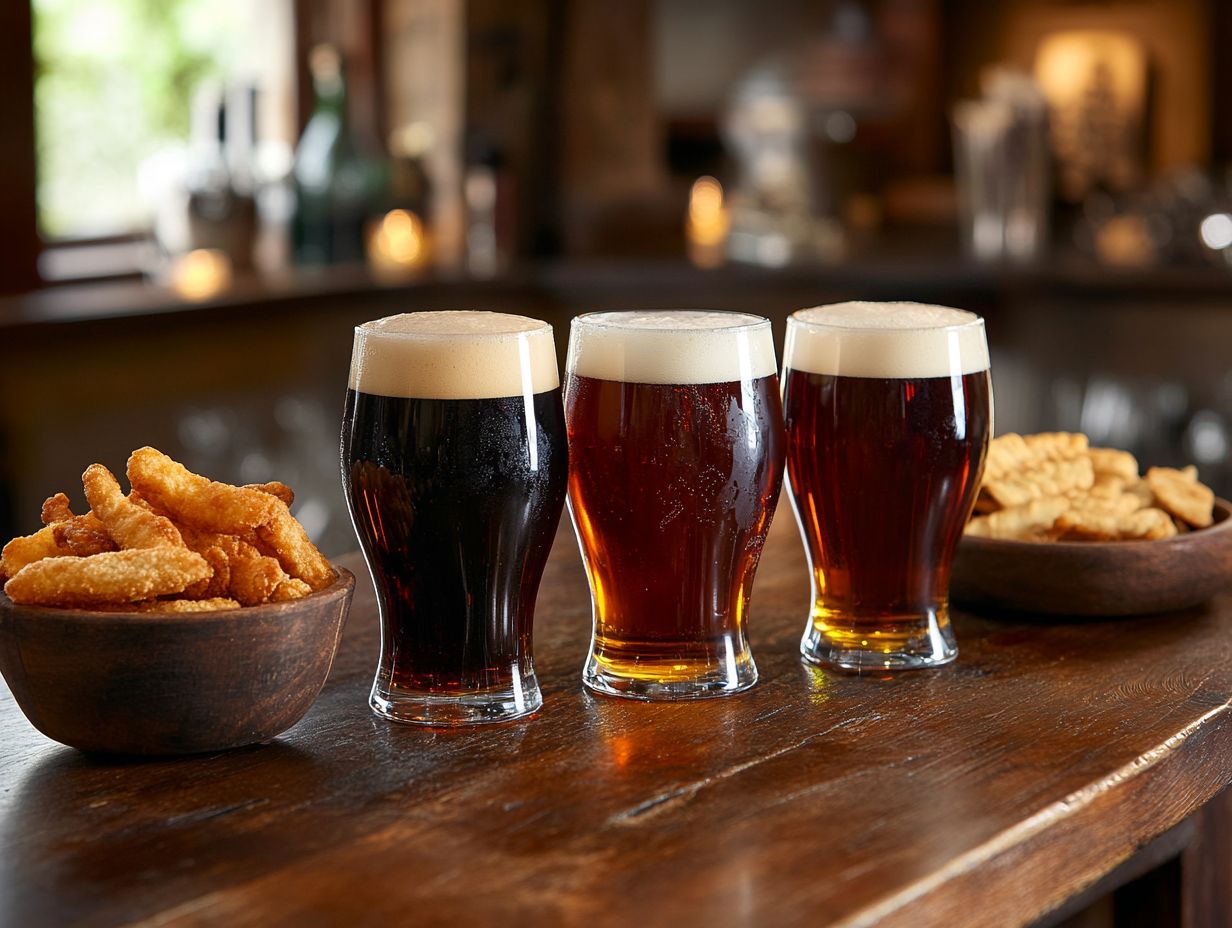
Traditional English ales present a rich tapestry of styles, each distinguished by its own unique characteristics. From the refreshing notes of Pale Ale to the deep, complex flavors of Brown Ale, and the robust profiles of Porter and Stout, there’s an entire spectrum of flavors and aromas waiting for you to discover. Exciting examples include the English Sweet Stout, Baltic Porter, and English Barleywine, which offer a sweet variation to the traditional profiles.
1. Pale Ale
Pale Ale, particularly the English IPA variant, stands out for its vibrant flavor profile, marked by a well-balanced bitterness and enticing floral hop aromas.
This style boasts rich historical roots, tracing back to the brewing traditions of England in the 18th century. It was during this era that brewers began to experiment with pale malts and innovative hopping techniques, aiming to craft a refreshing beverage that could be enjoyed by individuals across all social classes.
Commercial examples like Jaipur IPA and Fullers ESB are testament to the enduring appeal of this style. Over the years, Pale Ale has evolved, leading to notable examples like the classic Bass Ale and Wychwood’s Hobgoblin. These showcase a delightful range of malt sweetness and hop character.
As one of the most popular English beers, Pale Ale has inspired other styles such as the India Pale Ale (IPA) and English IPA, known for their strong hop profiles. What truly distinguishes this ale from others, such as stouts or porters, is its relatively lighter color and the prominent floral and citrus notes that provide a refreshing contrast to the darker ales typical of the English brewing tradition.
This also applies to lighter styles like English Mild Ale, which is known for its low alcohol content and mild flavor.
2. Brown Ale
Brown Ale is a traditional English ale that captivates with its rich, nutty aromas and smooth, malty sweetness, making it a favorite among discerning beer lovers. English Mild Ale and English Old Ale are other styles that also boast nutty aromas and complex flavors, further enriching the category of traditional English ales.
This distinctive beer style is defined by its dark amber to brown color, a result of using roasted malts during the brewing process. When brewing Brown Ale, an infusion mash (a method of mixing heated water with milled grains to extract sugars) is typically employed to extract its caramelized sugars, leading to a pleasantly sweet yet well-balanced flavor profile.
You might notice delightful hints of chocolate, toffee, and subtle hop notes that elegantly round out the experience. The rich malt character is what makes this style stand out.
Exciting examples of this style, such as Newcastle Brown Ale and Samuel Smith’s Nut Brown Ale, perfectly illustrate the traditional methods and ingredients that have solidified Brown Ale’s status as a cornerstone of English brewing culture. Commercial examples also include Ossian and Heineken Nederland B.V.’s offerings, which highlight the diversity within this style.
Dive into the world of traditional English ales today and discover your new favorite brew!
3. Porter
Porter is a dark, robust beer that offers you a rich roasted body and a complex flavor profile. It often reveals delightful notes of chocolate and coffee, which are hallmarks of the English Porter style. This revered style originated in London during the 18th century, initially created for the working class, celebrated for its affordability and satisfying qualities. Over time, Porter has evolved into variations like the Baltic Porter and English Porter.
As time marched on, the brewing techniques behind Porter evolved significantly. Increasingly refined malt roasting methods enhanced its signature depth. The inclusion of techniques from the British Empire and innovations in malt roasting have brought a new level of complexity to Porters.
Today, as an enthusiast, you can truly appreciate how this unique ale distinguishes itself within the broader landscape of traditional English ales don t miss out on tasting the incredible variations available! From a robust Porter with a punchier alcohol content to milk Porters that incorporate lactose, a sugar found in milk that adds sweetness, the versatility of Porter invites brewers to explore endless creative possibilities.
In this way, Porter not only captures the essence of historical brewing but also boldly pushes the boundaries with modern takes on this classic beverage. For example, Baltic Porter offers a unique twist by incorporating a lager yeast and a longer fermentation process, resulting in a smoother finish.
4. Stout
Stout captivates with its dark hue, creamy texture, and an array of rich flavors, often elevated by seasonal spices, especially in varieties like English Stout. The toasty Stouts are perfect examples of how brewing history and modern innovation can create exceptional beers with strong character.
Among the different styles, Sweet Stout particularly draws attention with its smooth, dessert-like essence. The inclusion of lactose imparts a subtle sweetness that beautifully balances the bitterness of the roasted malts. English Sweet Stout and English Oatmeal Stout are notable variations within this category.
Oatmeal Stout, in contrast, introduces oats into the brewing process. This creates a velvety mouthfeel that pairs exquisitely with its deep, chocolatey undertones. This sweet variation of stout highlights the creativity of brewers and their ability to innovate within traditional styles.
Both styles showcase the classic characteristics of traditional English ales. They embrace robust malt flavors while adding a unique twist through innovative ingredients and brewing techniques.
These variations not only highlight the creativity of brewers but also cater to a diverse range of palates, celebrating the versatility that makes this style so beloved. Many stouts pair wonderfully with hearty beef dishes, showcasing their robustness and depth of flavor.
What Are the Ingredients Used in Traditional English Ales?
The primary ingredients in traditional English ales Barley Malt, Hops, Yeast, and Water are essential. Each contributes a distinct and vital role in the brewing process as well as in the development of flavor. These key ingredients have been used for centuries, reflecting the deep-rooted Celtic tradition in English brewing history.
1. Barley Malt
Barley malt serves as the backbone of traditional English ales, providing the essential malt character that brings sweetness and body to the brew. Different types of barley malt, including caramel or crystal malts, contribute to the rich, diverse flavor profile of these ales.
This vital ingredient is derived from various types of barley malt, each offering its own unique flavors and colors to your beer. Breweries often use pale malts for their light, crisp profile, while caramel or crystal malts are blended in to enhance richness and sweetness. This results in a beautifully complex mouthfeel evident in various commercial examples of traditional English ales.
On the other end of the spectrum, darker malts like roasted barley not only deepen the color but also introduce delightful roasted, chocolatey notes that create a rich, full-bodied flavor experience.
The malting process, which involves steeping, germination, and kilning, is crucial in shaping these characteristics. This intricate method ultimately influences the overall taste and appeal of the final beer, making it a masterpiece worth savoring.
Traditional English Ales
2. Hops
Hops play a pivotal role in traditional English ales, infusing them with bitterness and aroma that perfectly balance the sweetness of the malt especially in styles like English IPA. English Bitter, Ordinary Bitter, and Best Bitter are other hop-forward styles that showcase the importance of hops in achieving a balanced flavor profile.
As you explore different hop varieties, such as East Kent Goldings or Fuggles, you’ll discover a range of unique flavor profiles, from earthy and floral to vibrant citrusy and herbal notes. These characteristics elevate the complexity of the ales and foster a harmonious relationship between the hops and the malt backbone.
In hop-forward styles like American IPAs or double IPAs, brewers often employ a diverse array of hop types think Citra, Mosaic, and Simcoe to amplify those tropical, piney, and resinous flavors. This meticulous selection and blending of hops shape your drinking experience, turning each sip into a delightful journey through a rich tapestry of taste sensations.
CAMRA, the Campaign for Real Ale, often highlights such distinctive hop varieties in their promotions.
3. Yeast
Yeast plays an essential role in the fermentation process of traditional English ales, shaping flavor development and contributing to their unique characteristics. The fermentation process is where yeast transforms sugars into alcohol, resulting in the strong character and complex flavors typical of traditional English ales.
Different strains of yeast produce a variety of flavors and aromas. For instance, ale yeasts like Saccharomyces cerevisiae typically thrive at warmer temperatures, often resulting in rich, fruity notes. Meanwhile, English ale yeasts emphasize a maltier profile, offering a balanced sweetness that enhances the overall experience.
The fermentation process varies significantly depending on the yeast type used. This means the nuances of top-fermenting yeasts, which rise to the surface during fermentation, and bottom-fermenting types, which settle at the bottom, not only influence the taste but also affect the mouthfeel and complexity of the final product.
Mastering these nuances is crucial for any brewer who wants to create unforgettable ales.
4. Water

Water is an essential element in traditional English ales, and its mineral content plays a pivotal role in both the brewing process and the final flavor profile of the beer. The quality of water is of utmost importance, serving not just as a solvent for the various ingredients but also being integral to the fermentation process. Different styles, such as English Barleywine and English Old Ale, benefit greatly from the specific water profiles of their regions.
You ll find that different geographical regions boast distinct mineral compositions. For instance, the hard water in places like Burton-upon-Trent, rich in sulfates, enhances hop bitterness, while the softer water from other areas tends to promote a maltier profile. This variation significantly impacts brewing dynamics, requiring you to adapt your techniques to fully exploit the unique characteristics of your local water.
By understanding these differences, you can craft traditional ales that truly reflect their origins, creating a more authentic and delightful experience for those lucky enough to enjoy your brews.
How Are Traditional English Ales Brewed?
The brewing process of traditional English ales is a captivating art that transforms simple ingredients into extraordinary experiences! It unfolds through several key steps:
- Mashing
- Boiling
- Fermentation
- Aging
Each of these stages plays a vital role in shaping the final flavor and character of the beer, ensuring a rich and nuanced experience in every sip.
The Brewing Process
Brewing beer is a fascinating adventure that involves several important steps. Understanding these steps can help you craft the perfect brew right at home.
1. Mashing
Mashing is the first step in your brewing adventure. Here, you mix crushed malt with hot water, allowing enzymes to work their magic. These enzymes convert starches into fermentable sugars in the wort.
Pay close attention to temperature control. Typically, you ll mash at temperatures between 150 F and 160 F (65 C to 71 C). Each specific temperature setting activates different enzymes, ultimately influencing the flavor profile of your beer. For instance, a lower temperature may yield a drier beer with enhanced fermentability, while a higher temperature can lead to a sweeter brew with a fuller body.
The duration of the mashing process is equally important. It usually lasts between 60 to 90 minutes. This timing significantly influences how much sugar you extract, further shaping the overall character and mouthfeel of your beer.
2. Boiling
The boiling stage in brewing is a pivotal moment. It serves as a critical point for sterilization. Here, you introduce hops to impart both bitterness and aroma, significantly influencing the final flavor of your beer. This stage also helps to stabilize the beer, ensuring that it has a long shelf life and consistent taste.
During this essential phase, the timing of your hop additions becomes paramount. Early additions primarily contribute to bitterness, while later ones enhance the aroma and flavor. Careful timing of hop additions helps you create a beer that embodies the distinct characteristics of traditional English ales.
By skillfully managing the boiling duration and the timing of different hop types, you can achieve a harmonious balance between bitterness and aromatic complexity. This is especially true for styles such as English Bitter and India Pale Ale, renowned for their unique flavor.
The boiling process not only ensures the safety of your beer but also plays a vital role in shaping its character. It adds depth and richness to its taste. The choice of hops and malt character, influenced by the British Empire’s brewing history, contributes a strong character to the beer.
3. Fermentation
Fermentation techniques vary widely. Different styles like English Mild Ale, English IPA, and English Old Ale each require specialized approaches to achieve distinct flavor profiles.
Watch as the yeast works its magic, converting fermentable sugars into alcohol and carbon dioxide. This process shapes the beer’s distinctive flavor profile, especially in styles like Brown Ale and Baltic Porter, which develop complex, dark, and rich flavors.
This transformation occurs at meticulously controlled temperatures, typically between 60 F to 72 F (15 C to 22 C). These temperatures allow the yeast to thrive without producing any off-putting flavors. The duration of fermentation can vary, lasting from several days to a few weeks, depending on the specific characteristics desired in your ale.
The yeast strain you choose is pivotal in defining the beer’s profile. Some strains may introduce delightful fruity esters and spicy phenolics, while others provide a crisp, clean finish. Grasping and managing these factors is crucial for any brewer aspiring to craft a well-balanced and flavorful beer, whether it’s a Best Bitter or a Winter Warmer.
Now that you understand these essential steps, why not start your brewing adventure today?
4. Aging and Conditioning
Aging and conditioning times can significantly affect the final product, especially in styles like English Barleywine and English Sweet Stout.
Aging and conditioning are vital final steps in your journey of brewing traditional English ales, allowing the flavors to mature and develop a remarkable complexity before they meet the bottle. Techniques like barrel aging for English Old Ale or seasonal spices in Winter Warmer can add unique characteristics to your brew.
Various aging techniques can dramatically shape the final taste and aroma profile of your beer. Opting for barrel aging infuses unique characteristics from the wood, imparting delightful notes of vanilla, oak, or even subtle spice, depending on what the barrel previously held.
The duration of aging is equally important. Allowing your ale to age longer can soften any harsh flavors, create a smoother mouthfeel, and deepen the overall richness of the brew. Mastering effective conditioning is key, often involving careful control of temperature and time. This ensures that the diverse flavor components meld together seamlessly, leading to a balanced and truly satisfying experience for you and your guests. Aging a dark ruby ale like Fullers ESB or Newcastle Brown Ale results in an exceptional drink.
What Are the Best Food Pairings for Traditional English Ales?
You ll love how traditional English ales elevate your meals! Picture yourself savoring the rich flavors of both the ale and the dish, especially with hearty beef dishes, classic Fish and Chips, or the comforting embrace of Shepherd’s Pie.
Each sip complements the meal, creating a harmonious balance that transforms your dining experience into something truly special.
1. Roast Beef
Roast Beef stands as a timeless companion to traditional English ales, especially English Bitter. The beer s moderate bitterness, combined with its malt sweetness, enhances the rich flavors of the meat, creating a truly exquisite pairing. Ossian and Jaipur IPA are excellent commercial examples that pair beautifully with hearty beef dishes.
The magic between savory roast and the ale s rich flavors guarantees an unforgettable meal. The earthy notes of the beef find a perfect match in the herbal hops commonly found in these ales, adding a layer of complexity that elevates the overall taste sensation. The roasted body of the ale further complements the dish, making each bite a satisfying experience.
As you sip, the carbonation (the bubbles in beer) of the ale cuts through the richness of the beef, refreshing your palate with each delightful encounter. Whether you opt for a luxurious gravy or a simple mustard accompaniment, the mix of flavors encourages you to enjoy the robust character of both the dish and its liquid counterpart, making each meal truly unforgettable!
2. Fish and Chips
Fish and Chips stands as another iconic pairing, where English Pale Ale or even an English Mild offers a refreshing contrast to the crispy batter and flaky fish, enhancing the overall dining experience.
Imagine how the zesty hops of the ale slice through the richness of the fried coating, creating an invigorating balance that elevates each bite. As the light carbonation dances across your palate, it complements the hearty texture of the dish, turning every mouthful into a moment of pure enjoyment.
The beer s subtle malt sweetness beautifully harmonizes with the tenderness of the fish, while its bitterness adds a layer of depth. This classic combination transcends mere sustenance it transforms into a culinary delight that satisfies both your appetite and your senses.
Pairings
3. Shepherd’s Pie

Shepherd’s Pie pairs impeccably with Brown Ale, as the beer’s nutty and toasty flavors beautifully complement the savory filling. Each bite transforms into a satisfying experience, while the ale s creamy drinkability ensures that every mouthful is a delight.
The rich, meaty layers of the pie often crafted with tender lamb or beef find a perfect counterbalance in the ale s sweet malt flavors, adding remarkable depth to the dish. The slight bitterness of the Brown Ale cuts through the creamy mashed potatoes on top, elevating the entire meal.
As you savor this delightful dish, the caramel notes in the ale intertwine with the warmth of the vegetables. This introduces a new level of complexity to this beloved comfort food. This perfect pairing elevates the flavors while creating a cozy ambiance, making every meal unforgettable!
4. Cheese Platter
A cheese platter is an excellent opportunity to explore different beer styles, from English Stout to toasty Stouts and even English Porter. It transforms into a delightful treat when paired with English stout; the beer’s creamy texture and rich flavors elevate the variety of cheeses in a way that’s simply extraordinary.
For a truly special occasion, consider pairing with a seasonal Winter Warmer or an English Oatmeal Stout. This pairing highlights the inherent characteristics of each cheese while turning the tasting experience into something exceptionally memorable.
For example, the nutty notes of a sharp cheddar harmonize beautifully with the chocolatey undertones of the stout, creating a perfect balance that dances on your palate. The boldness of blue cheese is beautifully tempered by the smooth, caramel flavors of the beer, allowing for a dynamic interplay between the creamy and the robust.
As each sip of stout washes over your taste buds, it accentuates the distinct textures and complexities of the cheeses, making this combination an indulgent affair you ll want to savor.
Frequently Asked Questions
What are the main characteristics of traditional English ales?
Traditional English ales are typically full-bodied, low in carbonation, and have a strong malt flavor. They also tend to have a lower alcohol content compared to other beer styles. Examples include Ordinary Bitter, Best Bitter, and even English Sweet Stout.
What types of hops are commonly used in traditional English ales?
Traditionally, English ales use English hops such as Fuggles, Goldings, and Bramling Cross, which give a more subtle and earthy flavor compared to American hops.
What is the serving temperature for traditional English ales?
Traditional English ales are best served at cellar temperature, around 50-55 F (10-13 C), to fully bring out their flavors and aromas. This serving temperature enhances the malt character and nutty aromas typical of these brews.
What makes traditional English ales different from other beer styles?
English ales are known for their balance between malt and hops, with a focus on the malt flavors and a more restrained use of hops compared to American styles.
Are there different types of traditional English ales?
Yes, there are several different types of traditional English ales, including bitter, pale ale, brown ale, and porter. Each has its own unique characteristics and flavor profiles. For instance, CAMRA often champions a variety of traditional styles, ranging from English Barleywine to Winter Warmer.
Do traditional English ales pair well with food?
Absolutely! Traditional English ales pair well with many classic British dishes, such as fish and chips, shepherd’s pie, and bangers and mash. They also go well with hearty stews and roasted meats.
Explore traditional English ales further and share your experiences with these delightful pairings!

